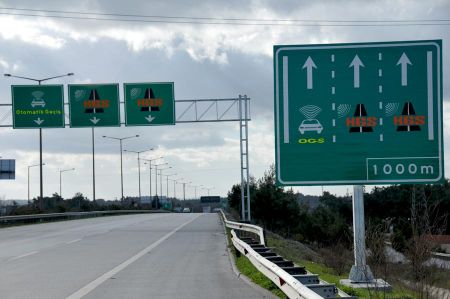The history of tolls or road user charges
- Written by Portal Editor
Just a few days ago we pointed out the changed rules for using the few Turkish motorways that have been technically modernized from the KGS system (rechargeable card) to the HGS system and have therefore initially caused problems for some motorway users.
You can of course drive onto the Autobahn at any time, even without a valid HGS vignette. Driving out is then only possible with a penalty, because the vehicle number is registered by photo and film. However, there is often a police station right at the exit, which of course registers the triggered alarm and stops "breaking through" vehicles.
But where does the road user fee come from? A modern invention?
no way! Tolls, tolls or "tithes" are very old terms for customs duties or fees that have almost always existed in the history of trade. Although the terms have changed over time, they always mean the same thing: the fee that is charged for using a bridge, a tunnel or just a road. The term “toll” alone is a term derived from the language of the Goths, which, loosely translated, is to be understood as customs, here meaning tolls on the road. Toll is one of the oldest fees or taxes in the history of human development, which has survived for thousands of years.
During our tours along Roman roads, we often came across bridges on which the fortifications for guarding were still clearly visible, despite the fact that they were often largely in ruins. Here it quickly becomes clear that the guarding by soldiers not only served to protect the bridge from malicious destruction, but also to collect the fee for the passage. Of course, the construction of the necessary infrastructure cost a lot of money at the time, which was at least partially returned to the budget through user fees.
So it's no wonder that even then, fees were charged for the use of roads and tunnels. The same applies to the fortifications along the Silk Road, the caravanserai along the trade routes in the Middle Ages in Asia Minor or in Europe. Here even small wooden bridges have been charged with "tolls" that travellers have passed. The same applies to fords, which were usually quickly used to cross rivers as a source of income. Over the course of history, many cities have been formed on these river passages, such as Schweinfurt, where even the name is based on a "river passage". And that a ferryman wants his labour and his boat or, more modern, his ferry to be paid for is certainly understandable.
The background to the levying of tolls was therefore always the participation of the traveller, whether private or as a dealer, in the costs that were necessary to set up the predominantly national infrastructure. In other words, travellers contribute directly to the cost of creating and maintaining this infrastructure. Alternatively, the only option would be to fund these facilities from tax revenue alone, which would be unfair to those who do not travel or use roads. But do such people really exist?
Cost sharing by road users
Today, in addition to terms such as Maut, Toll or Péage, there is also the purely German term road user fee. And for a long time now, this fee has not only been used to finance roads, bridges or tunnels, today environmental factors come into play that are intended to directly influence traffic or are only intended to provide an overview of traffic development in order to have an influence. In the past, there have been heated discussions about road user charges for trucks and the introduction of the technically very complex control system, as well as the still controversial discussions about the participation of foreign road users, at least in Germany.
In many European countries, drivers are asked to contribute extremely heavily to the costs of bridges, tunnels or motorways, so why not vice versa from foreigners in Germany? If you want to drive south, say for a holiday in Turkey, the vignette for Austria alone costs €8.30, plus two tunnel systems at €6.50 each. If you are then on the road for longer than 7 days, the same fee for the passage through Austria also applies on the way back. A hefty amount of €21.30 to use around 226 kilometres of motorway. The same applies to Slovenia, where the one-time drive through of around 177 kilometres also costs €15.
Toll Collect and similar systems
Although Germany has now set up the Toll Collect system, this still only applies to trucks. Toll Collect works as a satellite-supported toll collection system that, based on the length of the motorway kilometres used, collects the charges for road use from the carriers. Initially associated with great initial difficulties, since January 1, 2005 there has been a functioning, albeit limited, GPS variant that is in operation. Again and again the discussion about the road use fee for passenger cars appears in the media on the part of politicians, but so far, mainly due to the protests of the automobile clubs, there has been a quick backtrack.
In Turkey, as well as in Germany and many other countries, private investors have also been increasingly involved in motorway construction in recent years. After many bad business investments, some of which led to real losses for investors, road construction has become a real alternative investment that will certainly bring good returns in the long term. The buzzword here is public-private partnership – private investments in public road construction and returns through tolls or road user fees.
Whether via Toll Collect in Germany or the HGS system in Turkey, the task of both systems remains the collection of fees for road use or collection of fees for the use of special bridges or tunnels, whether in our modern, electronic age with GPS or vignette, Prepaid card or cash like in Greece.
Please read as well:
